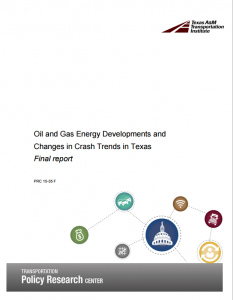Full Title: Oil and Gas Energy Developments and Changes in Crash Trends in Texas
Author(s): Cesar Quiroga and Ioannis Tsapakis
Publisher(s): Texas A&M Transportation Institute
Publication Date: October 1, 2015
Full Text: Download Resource
Description (excerpt):
In fall 2014, the Texas Legislature asked the Texas A&M Transportation Institute (TTI) to update a study completed in late 2011 documenting locations and trends of oil and gas energy developments in the state. As part of the study, the Texas Legislature asked TTI to correlate oil and gas developments with changes in pavement condition data. TTI summarized the results of this analysis in a report published in March 2015.
To complement the study, the Texas Legislature asked TTI to gather and process crash data at a level of spatial and temporal detail needed to document locations and trends of crashes in relation to oil and gas energy developments in the state. Location and attribute data about crashes and injuries (i.e., number of people who are injured in crashes) that the research team compiled included the following types of crashes:
- All crashes.
- Rural crashes (i.e., crashes that occur outside city limits).
- Crashes in which commercial motor vehicles (CMVs) are involved.
- Rural CMV crashes.
- Crashes on state highways.
- Crashes on rural state highways.
- CMV crashes on state highways.
- CMV crashes on rural state highways.
With this information, the research team examined changes in the number of crashes and the number of injuries from 2006–2009 to 2010–2013. These date ranges were used for consistency with those in the original March 2015 report. The year 2009 was significant because this was when accelerated oil production started in the Eagle Ford Shale region and oil production in the Permian Basin region began to accelerate, making the end of 2009 suitable for use as a baseline for comparison purposes. The last year with reliable Railroad Commission data was 2013 (2014 data were still preliminary). In addition, the economic recession of 2008 caused significant volatility in the oil markets, which resulted in dramatic swings in prices, drilling, and production. In order to reduce the impact of these variations, the research team aggregated and compared data using two four-year blocks: 2006–2009 and 2010–2013.
